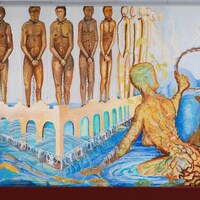"Katrina Jazz" by Perrin Green

Perrin “Lenny” Green’s 2006 mural, Katrina Jazz, shows various scenes connected by floodwaters, drawing inspiration from the artist’s personal experiences with Hurricane Katrina. In the upper left corner, a woman passes a swaddled baby to a man, referencing the biblical story of Moses being floated down the Nile River. Below them, a man clings to a sinking home, desperately hoping to avoid the fate of the drowned skeletons to his right. In the middle of the mural, a line of naked and chained enslaved people stand at an auction. This alludes to New Orleans’ history as the largest market for enslaved people in the United States in the 19th century. Under their feet, levees burst and water floods the city, replicating the disastrous chain of events wrought by Katrina. To the right, a faceless figure covered in vines shakes a tambourine. This is likely depicting Mami Wata, a water deity venerated in various West African, Caribbean, and Creole religious traditions. She is alongside an indigenous person, kneeling with raised hands that shoot rays into the sky. Lastly, in the upper right corner the skyline of New Orleans is visible, dominated by the silhouette of the Superdome, the football stadium where tens of thousands of refugees sheltered after the storm.
After Katrina devastated New Orleans, Green was one of hundreds of thousands of residents who evacuated to Houston. He enrolled in art classes at Texas Southern and permanently left his mark on campus through this masterful mural. His story and his composition reflect the ongoing nature of the African and Afro-American diaspora. Further, his depiction of Mami Wata evokes the enduring legacy of African spiritual traditions in New Orleans. While her origins are rooted in African mythology, Mami Wata's worship and veneration have spread across continents, particularly in regions influenced by the transatlantic slave trade. She is often depicted as a mermaid or water spirit, embodying the dual nature of water as both life-giving and potentially destructive. Many contemporary artists, like Green, have found Mami Wata to be a compelling figure through which to examine gender, race, environment, and transnational belonging. Green’s combination of religious, historical, and contemporary personal themes crafts a stunning and complex narrative. Sadly, Perrin “Lenny” Green passed away in November 2023 from an unexpected illness. He is remembered in New Orleans as a creative, talented, and kind member of the community. His obituary mentions his painting of Katrina Jazz, indicating just how significant the experience was to him.
This program is made possible in part by a grant from Humanities Texas, the state affiliate of the National Endowment for the Humanities.
